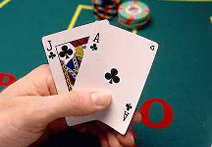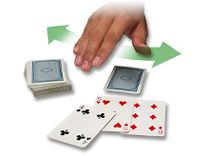

 If the first two cards drawn are an Ace and a 10 value card, that player has Blackjack and will be paid one and one-half times the wager (3 to 2) unless the dealer also has Blackjack.
If the first two cards drawn are an Ace and a 10 value card, that player has Blackjack and will be paid one and one-half times the wager (3 to 2) unless the dealer also has Blackjack.The Player not having Blackjack may continue to draw cards attempting to total as close to 21 as possible without exceeding 21, in which case that player “busts” and loses the wager.
Dealer must hit on all totals of 16 or less. Dealer must stand on all totals of 17 or more.
Blackjack Terminology:
Hit
The taking of an additional card.
Stand
Take no additional cards
Split
The Player will match the original wager and split the first two cards into two separate hands. The two cards must be of the same point value (i.e. a pair of 8’s, Jack and Queen, etc.) In split hands an Ace and ten are considered “21” and not blackjack.
Double Down
The player will match the original on the first two cards dealt and receive only one additional card. Double down wagering is not permitted on a Blackjack.
Insurance
When the dealer’s up card is an Ace, a player may buy insurance, an additional amount equal to half of that Player’s original wager. If the Dealer has Blackjack, the insurance wager pays 2 to 1. If the dealer does not have Blackjack, the insurance wager loses and the game continues as usual. A Blackjack will beat a point total of “21”. A player that has been dealt a blackjack can also take insurance by accepting even money for their blackjack.
| HIT |
 |
| Tap the table to signify that you want another card
|
| STAND |
 |
| wave your hand left and right to signify that you do not want any more cards |
